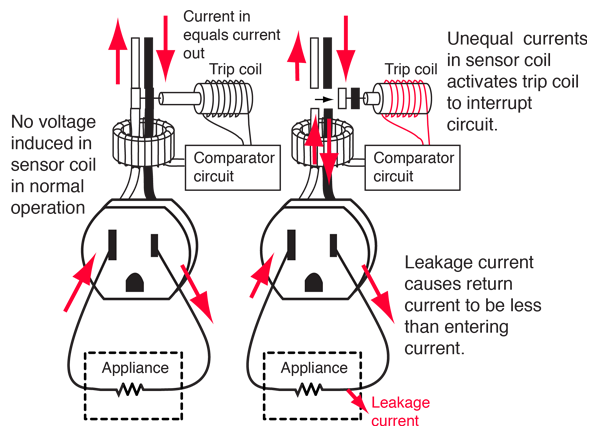Ground Fault Interrupter
Ground fault interrupters are designed to protect from electrical shock by interrupting a household circuit when there is a difference in the currents in the "hot" and neutral wires. Such a difference indicates that an abnormal diversion of current from the "hot" wire is occuring. Such a current might be flowing in the ground wire, such as a leakage current from a motor or from capacitors. More importantly, that current diversion may be occurring because a person has come into contact with the "hot" wire and is being shocked. When a circuit is functioning normally, all the return current from an appliance flows through the neutral wire, so the presence of a difference between "hot" and neutral currents represents a malfunction which in some circumstances could produce a dangerous or even lethal shock hazard.

The "hot" and neutral wires are passed through the sensing coil so that the currents in the two wires at any instant are traveling in opposite directions, giving a net zero current in the coil if the two currents are exactly equal. Since a current-carrying wire produces an AC magnetic field external to the wire, a non-zero current would induce a voltage in the sensing coil. The sensing coil is wound longitudinally to capture more of the wire's magnetic field and therefore be a more sensitive net current detector. Even so, the difference that it is supposed to detect is quite small. The GFI is designed to trip when there is more than 5 milliamperes of leakage current out of the normal pathway. The neutral return would then have 5 mA less current than the "hot" wire, but that might be out of a 20A load. So the circuit would have to detect a 0.025% deviation from 20A return current. Fortunately, comparator circuits such as an op-amp comparator are quite capable of detecting such differences. The voltage in the sensor coil is rectified and applied to the input of the sensitive comparator. The comparator activates a trip coil which opens both the "hot" and neutral wires. If all circuits were wired with correct polarity, opening the "hot" wire would be sufficient, but since it is not uncommon for them to be accidentally wired backward, it is prudent to interrupt both leads.
It is common household practice to wire several receptacles on a given circuit. A single GFI at the circuit panel will protect the entire collection of receptacles since a difference between "hot" and neutral current at any one of them will cause a difference at the GFI. A single GFI at one receptacle would not protect the entire circuit.
Because of the great sensitivity of the detection of current differences, GFIs are prone to nuisance tripping in certain applications. A rather common practice in some areas is to have a freezer on the carport, and carport receptacles are sometimes wired with GFIs. Under moist conditions you can sometimes get enough leakage current to trip the GFI, and persons come back to find their freezer thawed out. A necessary safety precaution in bathrooms and near pools, they are sometimes quite troublesome in outdoor applications where reliable power is needed. John de Armond has a good discussion of other circumstances which lead to nuisance tripping, particularly with campers and recreational vehicles.
| Why is a ground wire necessary? |
Practical circuit concepts
| HyperPhysics*****Electricity and magnetism | R Nave |